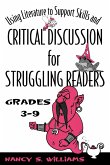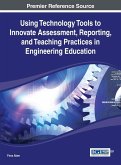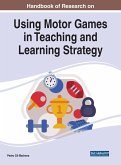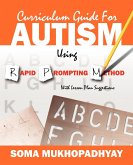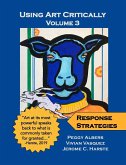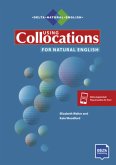- Broschiertes Buch
- Merkliste
- Auf die Merkliste
- Bewerten Bewerten
- Teilen
- Produkt teilen
- Produkterinnerung
- Produkterinnerung
This book offers practical advice to teachers unsure of how to teach spelling. Filled with student-centered wisdom, Burkhardt grounds her methods in both theory and practice, providing logical rules and hands-on exercises to keep students actively engaged.
Andere Kunden interessierten sich auch für
![Using Literature to Support Skills and Critical Discussion for Struggling Readers Using Literature to Support Skills and Critical Discussion for Struggling Readers]() Nancy S. WilliamsUsing Literature to Support Skills and Critical Discussion for Struggling Readers72,99 €
Nancy S. WilliamsUsing Literature to Support Skills and Critical Discussion for Struggling Readers72,99 €![Using Technology Tools to Innovate Assessment, Reporting, and Teaching Practices in Engineering Education Using Technology Tools to Innovate Assessment, Reporting, and Teaching Practices in Engineering Education]() Using Technology Tools to Innovate Assessment, Reporting, and Teaching Practices in Engineering Education201,99 €
Using Technology Tools to Innovate Assessment, Reporting, and Teaching Practices in Engineering Education201,99 €![Using Developmentally Appropriate Practices to Teach the Common Core Using Developmentally Appropriate Practices to Teach the Common Core]() Lisa S. GoldsteinUsing Developmentally Appropriate Practices to Teach the Common Core189,99 €
Lisa S. GoldsteinUsing Developmentally Appropriate Practices to Teach the Common Core189,99 €![Handbook of Research on Using Motor Games in Teaching and Learning Strategy Handbook of Research on Using Motor Games in Teaching and Learning Strategy]() Handbook of Research on Using Motor Games in Teaching and Learning Strategy246,99 €
Handbook of Research on Using Motor Games in Teaching and Learning Strategy246,99 €![Curriculum Guide for Autism Using Rapid Prompting Method Curriculum Guide for Autism Using Rapid Prompting Method]() Soma MukhopadhyayCurriculum Guide for Autism Using Rapid Prompting Method43,99 €
Soma MukhopadhyayCurriculum Guide for Autism Using Rapid Prompting Method43,99 €![Using Art Critically - Volume 3 Using Art Critically - Volume 3]() Peggy AlbersUsing Art Critically - Volume 333,99 €
Peggy AlbersUsing Art Critically - Volume 333,99 €![Using Collocations for Natural English Using Collocations for Natural English]() Elizabeth WalterUsing Collocations for Natural English31,00 €
Elizabeth WalterUsing Collocations for Natural English31,00 €-
-
-
This book offers practical advice to teachers unsure of how to teach spelling. Filled with student-centered wisdom, Burkhardt grounds her methods in both theory and practice, providing logical rules and hands-on exercises to keep students actively engaged.
Produktdetails
- Produktdetails
- Verlag: R&L Education
- Seitenzahl: 318
- Erscheinungstermin: 16. Juni 2011
- Englisch
- Abmessung: 234mm x 156mm x 17mm
- Gewicht: 485g
- ISBN-13: 9781607096993
- ISBN-10: 1607096994
- Artikelnr.: 30165625
- Herstellerkennzeichnung
- Libri GmbH
- Europaallee 1
- 36244 Bad Hersfeld
- gpsr@libri.de
- Verlag: R&L Education
- Seitenzahl: 318
- Erscheinungstermin: 16. Juni 2011
- Englisch
- Abmessung: 234mm x 156mm x 17mm
- Gewicht: 485g
- ISBN-13: 9781607096993
- ISBN-10: 1607096994
- Artikelnr.: 30165625
- Herstellerkennzeichnung
- Libri GmbH
- Europaallee 1
- 36244 Bad Hersfeld
- gpsr@libri.de
Sally E. Burkhardt is a retired English teacher, who taught in the middle grades for more than fourteen years. She has also served as a Fellow in the Capital Writing Project at Virginia Commonwealth University. Visit her website at braintospell.com.
Chapter 1 In the Beginning - Underlying Educational Principles
Chapter 2 Priming the Spelling Pump - Basic Strategies that Promote
Spelling Ability
Chapter 3 Using Logic to Spell - Teaching Poor Spellers to Apply Sound -
Letter Strategies
Chapter 4 Focusing on Letter Patterns - Helping Weak Spellers to Use
Visualization Strategies
Chapter 5 Eye Openers - Activities to Help Poor Spellers to Notice and
Remember Common Deviant Letter Combinations in Words
Chapter 6 Rules Rule - Learning to Apply Spelling Rules Will Improve
Spelling Ability
Chapter 7 Which One? - Teaching Students Memory Trick Writing to Remember
Homonyms and Words Commonly Confused
Chapter 8 Fine Tuning - Activities for Advanced Spellers
Part 9 Appendixes
Chapter 10 A.Richard J. Gentry's List of 500 Most Frequently Used Words in
Childrenís Writing Reorganized by Patterns
Chapter 11 B.Example Words Illustrating Multiple Spellings of the Schwa
Sound
Chapter 12 C.A Source List of Multi-Syllable Words for Further Logical
Spelling Practice
Chapter 13 D.Student Assignment Sheets to Reinforce Logical Spelling
Principles
Chapter 14 E.Student Assignment for Answering Questions on Logical Spelling
Principles
Chapter 15 F.Word Bank of Words Containing Deviant Letter Patterns
Chapter 16 G.Word Bank of Words Containing Double Consonants
Chapter 17 H.List of Tongue Twisters in Alphabetical Order According to
Each Twister's Beginning Consonant
Chapter 18 I.Spelling Rules Science Key
Chapter 19 J.Word Bank for Application of Basic Spelling Rules
Chapter 20 K.Basic Spelling Rules in Outline Format
Chapter 21 L.Word Bank for Application of Spelling Rules for Doubling a
Final Consonant
Chapter 22 M.Word Bank of Exceptions to Spelling Rules
Chapter 23 N.Source List for Writing Memory Tricks for Spellings of
Homonyms
Chapter 24 O.Student Worksheet for Spelling Correctly "their," "there,"
"they're," "to," "too," and "two"
Chapter 25 P.Source List for Writing Memory Tricks for Spellings of Words
Often Confused
Chapter 26 Q.List of Words that Have Interesting Entomologies
Chapter 27 R.Student Worksheet for Guessing the Meanings of Vocabulary
Words Used in Context
Chapter 28 S. Noun, Verb, Adjective, and Adverb Suffixes
Chapter 29 T.Words that Each Have a Minimum of Four Grammatical Forms
Chapter 30 U.Word Web Generating from the Roots "-Spec-," "-Spect-," and
"-Spic-"
Chapter 31 V.Magniloquence Word List
Chapter 2 Priming the Spelling Pump - Basic Strategies that Promote
Spelling Ability
Chapter 3 Using Logic to Spell - Teaching Poor Spellers to Apply Sound -
Letter Strategies
Chapter 4 Focusing on Letter Patterns - Helping Weak Spellers to Use
Visualization Strategies
Chapter 5 Eye Openers - Activities to Help Poor Spellers to Notice and
Remember Common Deviant Letter Combinations in Words
Chapter 6 Rules Rule - Learning to Apply Spelling Rules Will Improve
Spelling Ability
Chapter 7 Which One? - Teaching Students Memory Trick Writing to Remember
Homonyms and Words Commonly Confused
Chapter 8 Fine Tuning - Activities for Advanced Spellers
Part 9 Appendixes
Chapter 10 A.Richard J. Gentry's List of 500 Most Frequently Used Words in
Childrenís Writing Reorganized by Patterns
Chapter 11 B.Example Words Illustrating Multiple Spellings of the Schwa
Sound
Chapter 12 C.A Source List of Multi-Syllable Words for Further Logical
Spelling Practice
Chapter 13 D.Student Assignment Sheets to Reinforce Logical Spelling
Principles
Chapter 14 E.Student Assignment for Answering Questions on Logical Spelling
Principles
Chapter 15 F.Word Bank of Words Containing Deviant Letter Patterns
Chapter 16 G.Word Bank of Words Containing Double Consonants
Chapter 17 H.List of Tongue Twisters in Alphabetical Order According to
Each Twister's Beginning Consonant
Chapter 18 I.Spelling Rules Science Key
Chapter 19 J.Word Bank for Application of Basic Spelling Rules
Chapter 20 K.Basic Spelling Rules in Outline Format
Chapter 21 L.Word Bank for Application of Spelling Rules for Doubling a
Final Consonant
Chapter 22 M.Word Bank of Exceptions to Spelling Rules
Chapter 23 N.Source List for Writing Memory Tricks for Spellings of
Homonyms
Chapter 24 O.Student Worksheet for Spelling Correctly "their," "there,"
"they're," "to," "too," and "two"
Chapter 25 P.Source List for Writing Memory Tricks for Spellings of Words
Often Confused
Chapter 26 Q.List of Words that Have Interesting Entomologies
Chapter 27 R.Student Worksheet for Guessing the Meanings of Vocabulary
Words Used in Context
Chapter 28 S. Noun, Verb, Adjective, and Adverb Suffixes
Chapter 29 T.Words that Each Have a Minimum of Four Grammatical Forms
Chapter 30 U.Word Web Generating from the Roots "-Spec-," "-Spect-," and
"-Spic-"
Chapter 31 V.Magniloquence Word List
Chapter 1 In the Beginning - Underlying Educational Principles
Chapter 2 Priming the Spelling Pump - Basic Strategies that Promote
Spelling Ability
Chapter 3 Using Logic to Spell - Teaching Poor Spellers to Apply Sound -
Letter Strategies
Chapter 4 Focusing on Letter Patterns - Helping Weak Spellers to Use
Visualization Strategies
Chapter 5 Eye Openers - Activities to Help Poor Spellers to Notice and
Remember Common Deviant Letter Combinations in Words
Chapter 6 Rules Rule - Learning to Apply Spelling Rules Will Improve
Spelling Ability
Chapter 7 Which One? - Teaching Students Memory Trick Writing to Remember
Homonyms and Words Commonly Confused
Chapter 8 Fine Tuning - Activities for Advanced Spellers
Part 9 Appendixes
Chapter 10 A.Richard J. Gentry's List of 500 Most Frequently Used Words in
Childrenís Writing Reorganized by Patterns
Chapter 11 B.Example Words Illustrating Multiple Spellings of the Schwa
Sound
Chapter 12 C.A Source List of Multi-Syllable Words for Further Logical
Spelling Practice
Chapter 13 D.Student Assignment Sheets to Reinforce Logical Spelling
Principles
Chapter 14 E.Student Assignment for Answering Questions on Logical Spelling
Principles
Chapter 15 F.Word Bank of Words Containing Deviant Letter Patterns
Chapter 16 G.Word Bank of Words Containing Double Consonants
Chapter 17 H.List of Tongue Twisters in Alphabetical Order According to
Each Twister's Beginning Consonant
Chapter 18 I.Spelling Rules Science Key
Chapter 19 J.Word Bank for Application of Basic Spelling Rules
Chapter 20 K.Basic Spelling Rules in Outline Format
Chapter 21 L.Word Bank for Application of Spelling Rules for Doubling a
Final Consonant
Chapter 22 M.Word Bank of Exceptions to Spelling Rules
Chapter 23 N.Source List for Writing Memory Tricks for Spellings of
Homonyms
Chapter 24 O.Student Worksheet for Spelling Correctly "their," "there,"
"they're," "to," "too," and "two"
Chapter 25 P.Source List for Writing Memory Tricks for Spellings of Words
Often Confused
Chapter 26 Q.List of Words that Have Interesting Entomologies
Chapter 27 R.Student Worksheet for Guessing the Meanings of Vocabulary
Words Used in Context
Chapter 28 S. Noun, Verb, Adjective, and Adverb Suffixes
Chapter 29 T.Words that Each Have a Minimum of Four Grammatical Forms
Chapter 30 U.Word Web Generating from the Roots "-Spec-," "-Spect-," and
"-Spic-"
Chapter 31 V.Magniloquence Word List
Chapter 2 Priming the Spelling Pump - Basic Strategies that Promote
Spelling Ability
Chapter 3 Using Logic to Spell - Teaching Poor Spellers to Apply Sound -
Letter Strategies
Chapter 4 Focusing on Letter Patterns - Helping Weak Spellers to Use
Visualization Strategies
Chapter 5 Eye Openers - Activities to Help Poor Spellers to Notice and
Remember Common Deviant Letter Combinations in Words
Chapter 6 Rules Rule - Learning to Apply Spelling Rules Will Improve
Spelling Ability
Chapter 7 Which One? - Teaching Students Memory Trick Writing to Remember
Homonyms and Words Commonly Confused
Chapter 8 Fine Tuning - Activities for Advanced Spellers
Part 9 Appendixes
Chapter 10 A.Richard J. Gentry's List of 500 Most Frequently Used Words in
Childrenís Writing Reorganized by Patterns
Chapter 11 B.Example Words Illustrating Multiple Spellings of the Schwa
Sound
Chapter 12 C.A Source List of Multi-Syllable Words for Further Logical
Spelling Practice
Chapter 13 D.Student Assignment Sheets to Reinforce Logical Spelling
Principles
Chapter 14 E.Student Assignment for Answering Questions on Logical Spelling
Principles
Chapter 15 F.Word Bank of Words Containing Deviant Letter Patterns
Chapter 16 G.Word Bank of Words Containing Double Consonants
Chapter 17 H.List of Tongue Twisters in Alphabetical Order According to
Each Twister's Beginning Consonant
Chapter 18 I.Spelling Rules Science Key
Chapter 19 J.Word Bank for Application of Basic Spelling Rules
Chapter 20 K.Basic Spelling Rules in Outline Format
Chapter 21 L.Word Bank for Application of Spelling Rules for Doubling a
Final Consonant
Chapter 22 M.Word Bank of Exceptions to Spelling Rules
Chapter 23 N.Source List for Writing Memory Tricks for Spellings of
Homonyms
Chapter 24 O.Student Worksheet for Spelling Correctly "their," "there,"
"they're," "to," "too," and "two"
Chapter 25 P.Source List for Writing Memory Tricks for Spellings of Words
Often Confused
Chapter 26 Q.List of Words that Have Interesting Entomologies
Chapter 27 R.Student Worksheet for Guessing the Meanings of Vocabulary
Words Used in Context
Chapter 28 S. Noun, Verb, Adjective, and Adverb Suffixes
Chapter 29 T.Words that Each Have a Minimum of Four Grammatical Forms
Chapter 30 U.Word Web Generating from the Roots "-Spec-," "-Spect-," and
"-Spic-"
Chapter 31 V.Magniloquence Word List



